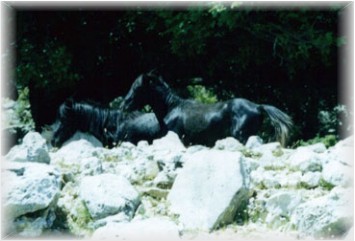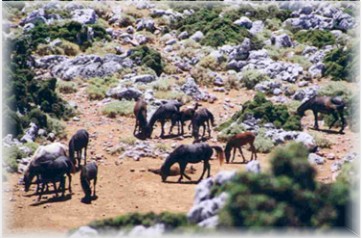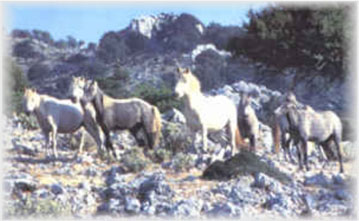|
|
|
THE WILD HORSES OF
MOUNT AINOS |
|
|
|
|
|
Also
described as the semi-wild Ainos ponies. There are two schools of thought
here, one is that these are not wild horses at all but semi-wild ponies,
that owe their existence to the villagers' old custom of keeping herds of
horses free on the mountain in order to avoid the cost of feeding them and
that they were abandoned in the wild after the Second World
War. |
|
Over
the centuries countless domestic horses have escaped or were intentionally
released, they formed into small herds and the strongest flourished. Their
populations only checked by the supply of food and water Therefore in the
scientific sense, these animals are actually domestic horses returned to
the wild. |
|
Even free roaming (but not wild horses) can lead a good life up to 25 years or more, provided of course that they are not suffering from any physical disability or disease. They share their territory with many native animals. Years ago there was enough food and water for all. However, due to many reasons, including over felling of trees in the past, as well as numerous destructive fires, times are hard. Especially after being left in isolated conditions on the slopes of the mountain. Struggling against adverse conditions, fending and rummaging for food and water. With the lack of natural shelter to protect them from the cold and snows of the winter and the droughts of the summer. Along with inbreeding for over 55 years I personally would call these animals wild - furthermore a pure breed. |
|
|
|
The
Ainos horses are endangered. |
|
They
live on the mountain above the village of Arginia and exist around the
area surrounding the Monastery of Zoodohou Pigis ironically called 'The Source of Life'. This once
overflowing fountain is Ainosís one and only freshwater spring and now
feeds two huge concrete water butts. |
|
So the
now scant supply of spring water quenches the thirst of sheep, goats,
humans and horses alike. |
|
These
few horses not only eat much of the food needed and left by farmers for
other grazing animals, but they have destroyed much of the plant base over
the years in their desperate effort to get enough food. |
|
Thus,
in an unmanaged state, these horses could have a very negative impact on
the ecology of Mount
Ainos.
Some
consider them pests. A few have been killed and some
even captured. |
|
They
belong to a mountain breed of Greek horse that descended from the Pindos
breed, which the locals bought from cattle fairs held on the
mainland. |
|
There
are three Ancient breeds that are now extinct the Achean, Thessalonian and
Thracian |
|
The
Pindos is a descendent from the old Thessalonian breed and is known for
its stamina, allowing it to be used for light work both on the farm and in
the forest. They are also used for riding and driving, with the mares
frequently used for breeding mules. The endangered Ainos horses differ in
their stamina, but are more sure-footed when walking and trotting over the
rough mountain terrain. Between 10-12 hands (10cm is 1 hand). They have a
tough constitution and have adapted to living on the minimum amount of
food. They have a narrow body and have an extremely expressive head with a
rich mane and tail. Their colours are bay, grey and black roan which may
be of a blue colour with white hairs through the coat and are well
spirited, proud and somewhat aloof. |
|
There
are 18 left and although still successfully breeding they are virtually
extinct. |
|
A ruling should be
passed to protect, manage, and control wild horses on public and or
National Park lands. Furthermore free-roaming horses must be protected
from capture, harassment, or death. They are an integral part of the
natural system of public and or National Park lands. Also wild horses
should be considered similar to the other resource values within the area.
|
|
I would like to see a development for a recreation and viewing area for the public to observe the wild horses of Ainos (including other animal and bird life)
in a natural setting. |
|
|
|
|


